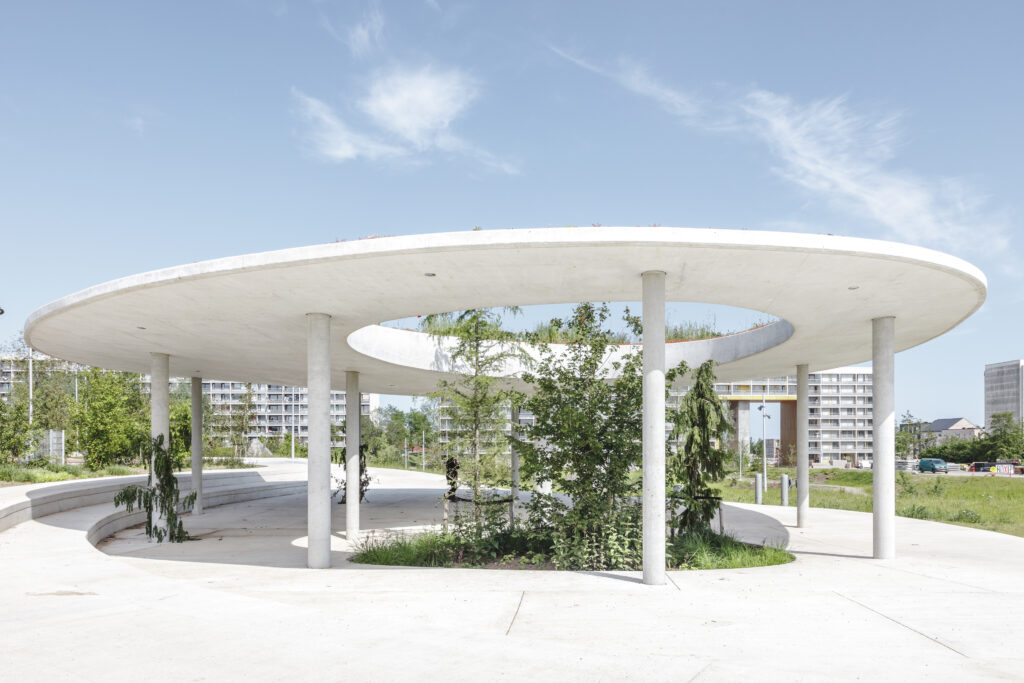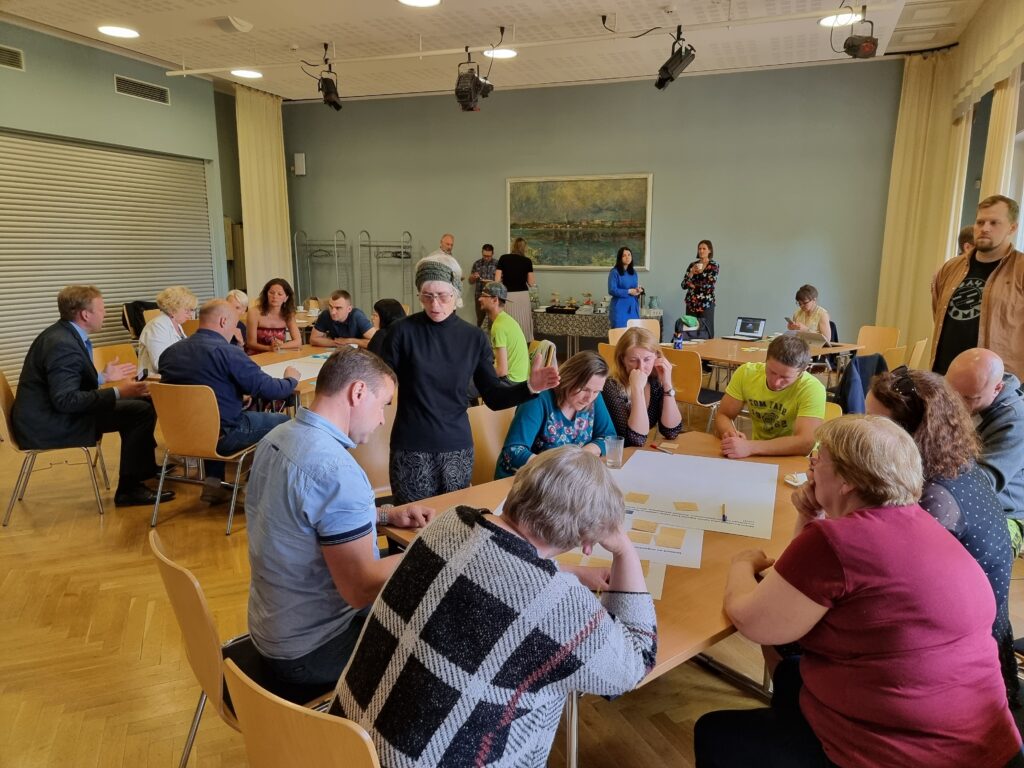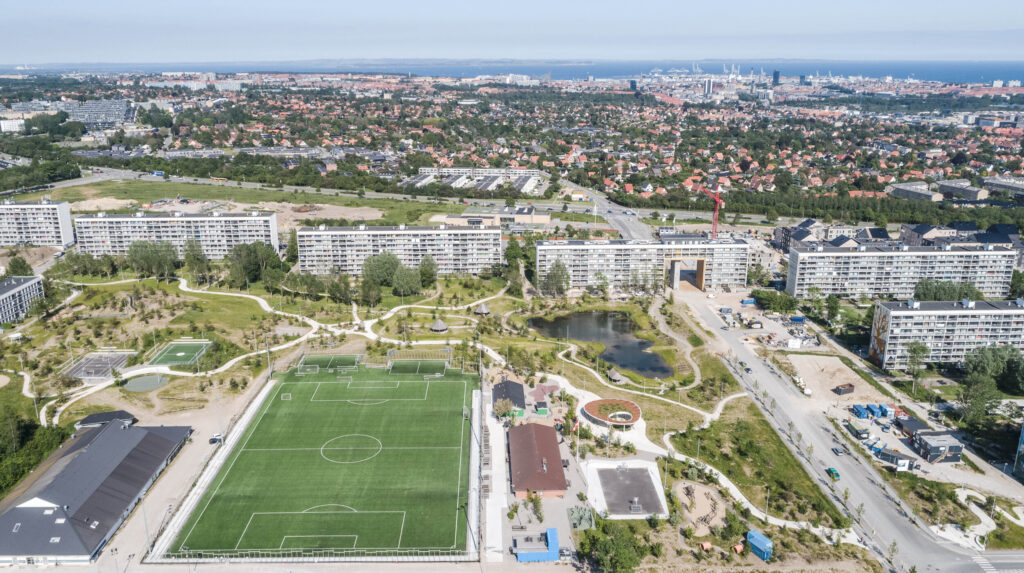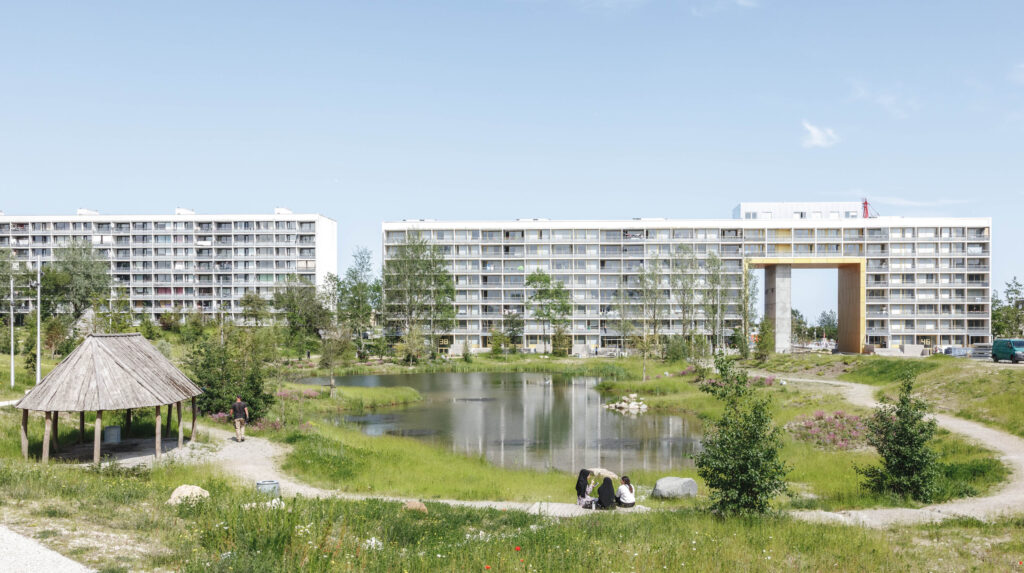Most buildings in Estonia have been built at the time when energy efficiency was not a priority. Today, these buildings are outdated and are in urgent need of renovation. Reducing the amount of energy consumed in buildings is currently one of the most effective ways to increase energy efficiency, which is why energy consumption requirements for buildings have become ever stricter over the last decade, and there have been continuous investments into the energy efficiency of the existing building stock. However, given that in free market conditions, only about 1% of real estate is renewed in a year,1 we can expect the renovation of Estonian buildings to last another 100 years. This is obviously too long, for many of the buildings require renovation immediately to stop their decay and save energy, as well as to modernise them.
Area-based renovation
So far, residential renovation has mainly targeted single buildings, but the idea of area-based renovation is becoming increasingly widespread. At the same time, as a term area-based renovation has not yet been clearly defined. There are disagreements over what kinds of problems should concurrent renovation within an area solve, as well as how to specify the area itself. Specification of the area (neighbourhood, block, subdistrict, district) is worthy of its own discussion, for the parties involved in renovation have very different opinions that range from improving spatial quality to energy donorship. Further confusion stems from related notions such as ‘group renovation’ and ‘community-based renovation’, which might overlap in content, but also might be used to designate wholly different kinds of initiatives, e.g., outreach work with the residents. In the following article, we will be considering areas of high-density delimited by streets, which we will henceforth call neighbourhoods.
Preconditions and expectations for neighbourhood-based renovation
Since there is little experience with neighbourhood-based renovation, for now, descriptions of hypothetical preconditions and expectations will have to suffice. Evidently neighbourhood-based renovation could boost construction volumes, which are of interest primarily to larger companies who are able to guarantee a better construction quality. In more peripheral areas, renovating several buildings at once is the only option for attracting the interest of companies for a reasonable price.
It is expected that by renovating several buildings at once (i.e., concurrent renovation) the construction price should be lower since contractors can work with larger volumes within the same location. This could have effects over the whole supply chain, for the producers of building materials could also save their costs due to economy of scale. In case of standard apartment buildings, it is also possible to design several buildings at once, and use modules that have been prefabricated in a factory, thus reducing the costs of on-site operations. Neighbourhood-based concurrent renovation enables better use of the space between the buildings for organising and managing the construction site. This in turn leads to less disturbance of the residents during renovation and a smaller environmental footprint.
So far, renovation of residential buildings has been designed mainly by engineers, however, with neighbourhood-based renovation, it is necessary to involve also architects and landscape architects who can contribute to the architectural design of the buildings as well as add value to public space between the renovated buildings. In addition to technical modernisation of buildings, neighbourhood-based renovation enables for new architectural solutions to stitch a neighbourhood together into a whole much better than renovating each building separately would. Commonly, each building has tried to solve its problems on its own, whereas neighbourhood-based renovation presents a unique opportunity to rethink and renew the function and design of also the semi-public space in the area, providing the residents with a better doorstep space. Thus, increasing the social capital and introducing collective action are no less important in a community. Extending the surface area of the building while renovating, for example, requires the consent of all apartment owners. Renovation is impeded by the prejudice that it is better to preserve what is already there than to go along with indeterminacy-inducing innovations—decisions are often made based on short-term gains rather than long-term benefits. Joint action, community outreach, and sometimes even the mentality of being ‘better than your neighbour’ could enable to break these kinds of barriers.

Who should lead neighbourhood-based renovation?
In areas of great public interest and serious business potential, developers themselves are motivated to redesign the whole neighbourhood, and for this reason, neighbourhood-based renovation is initiated by the private sector. In residential districts where property is highly fragmented and residents are unwilling to leave their dwellings, the private sector will have no such interest. This means that neighbourhood-based renovation has to be initiated by the local community or municipality. It is not yet known to what extent neighbourhood-based renovation will live up to its theoretical expectations, such as cheaper, faster, more convenient results, which is why communities and municipalities are not yet ready to take the initiative in renovating buildings in an area-based manner.
Given that the housing economy and ownership structure of the housing stock varies a lot from country to country, it is rather difficult to adopt the experiences of other countries. One widely known example is Gellerup, a residential area in the Danish city of Aarhus, which has initiated a district-wide reconstruction project. This involves not only the renovation of modernist apartment buildings, but also demolitions, new developments, and an ambitious re-organisation of the transport system. The initiative follows a detail plan by WE Architecture and is led by the district’s housing association, which is the actual owner of most buildings in Gellerup and not an association of owners like the apartment associations in Estonia usually are. Hence it is possible to reduce or increase the volumes of buildings, or even ‘break’ a way through them, for this is enabled by the form of ownership.
A countervailing example comes from the city of Detroit in the United States, where communities are leading the renovation of certain areas that have complex ownership structures. The city is financing this programme from the strategic fund of Detroit’s neighbourhoods, which was created together with private investors in 2016, and is used to support improvements in 11 neighbourhoods, mainly by renovating the existing building stock and revitalising the outdoor spaces. The initiative to tidy up the neighbourhoods came from the city, who is supporting the implementation of renovation works from building to building, as well as the beautification of these neighbourhoods.

Ongoing neighbourhood-based experiments in Estonia
In order to accelerate the renovation of buildings and ensure its quality, innovation project LIFE IP BuildEST2 (also known as the Renovation Marathon) was launched last year with the purpose of empowering all parties involved in the renovation process, alleviating any obstacles that come up during renovation, and creating novel solutions in the construction and energy sector (you can read more about it in the previous issue of Maja3). The project encompasses all types of buildings, including apartment blocks and detached houses. Research of and funding for apartment buildings renovations has been going on for more than ten years already. This has helped to develop a strong practice and good knowledge of solutions that work, such as advising apartment associations on planning and designing, financing, procuring and supervising renovations works. The Renovation Marathon aims to achieve a further leap forward among detached houses’ renovations as well.
One of the aspirations of the LIFE IP BuildEST project is to test whether and to what extent it is rational to renovate several buildings at once within a given area. But it is also a challenge to make concurrent renovation feasible in the first place. The neighbourhoods that have been picked for evaluation in the BuildEST innovation project are in the cities of Tartu and Võru, and the knowledge transferability will be tested in the city of Rakvere. In Tartu, the project will focus on neighbourhood-based renovation of detached houses, while in Võru, the focus is on the buildings of cultural value which requires specific attention in renovation solutions to preserve the heritage. This makes renovation more difficult, and the probability of making mistakes could be high. Thus, the knowledge and experience that is gained there should definitely be used to publish guidance materials.
In June, the European Urban Initiative granted funding to Tallinn-led SOFTacademy project,4 which will be piloted in the 1st micro-district of Mustamäe in Tallinn, the neighbourhood at the beginning of Akadeemia Road. The project launches in the next year and its purpose is to use the example of Mustamäe to develop a package of municipality-provided services and standard solutions that support outdoor spaces. These would then attract apartment associations in various residential districts to engage in group renovation. Renovation solutions for four sample buildings and their outdoor spaces will be developed in cooperation with local residents. The key move in all of the mentioned projects is to train the local residents and involve them in co-creation so that they could weigh in on developing their homes and neighbourhoods. The project teams will help to work out renovation solutions and to overcome potential obstacles to renovation. The experience that is gained will be published in the form of instructional materials, and there are also plans to provide consultations for renovation enthusiasts and develop new support measures.
What is already happening?
Some projects that support neighbourhood-based renovation have already been launched. In the sample areas of the BuildEST project in Tartu and Võru, surveys and interviews with local residents have been conducted to identify renovation barriers as well as motivations. In Tartu, workshops on renovating detached houses have been launched in several neighbourhoods. These will be used to make renovation-related instructional videos. The workshops and instructional videos will focus on topics that emerged in the responses to the surveys, like the technical performance of a building as well as typical mistakes in construction, and will also provide advice on how to calculate the feasibility of renovation, conclude the necessary contracts, and communicate with the municipal authorities. All the guidance materials created in the course of the project will be made available for free.
In the old town of Võru, buildings have already been inspected and renovation solutions are now being developed. In Tartu, the inspection of buildings will conclude in August, after which specific buildings will be selected and provided with more detailed sample solutions. In addition to the inspections, building consumption data is collected, which will then form the basis of energy calculations. Investment sizes and feasibility calculations for the sample renovations will be made public.
The most important part in neighbourhood-based renovation is played by the municipal authorities. Thus, the coordinating forces behind all the pilot areas of the Renovation Marathon are the city administrations of Tartu and Võru. We should also highlight the non-profit organisation Tartu Regional Energy Agency, which will be a valuable partner to other municipalities going forward and help them get started with neighbourhood-based renovation. Construction-related innovation and research is contributed by TalTech.
LAURI LIHTMAA makes data-based attempts to encourage more efficient and fairer uses of buildings and neighbourhoods.
MUREL TRUU‘s colourful professional background helps to draw connections between different disciplines. She believes in projects that can make the world better.
HEADER photo: Rasmus Hjortshøj / Effekt Architects
PUBLISHED: Maja 113 (summer 2023), with main topic Housing
1 Hoonete rekonstrueerimise pikaajaline strateegia. Tallinna Tehnikaülikooli Ehituse ja Arhitektuuri Instituut & Majandus- ja Kommunikatsiooniministeerium. Tallinn, 2020.
2 You can read more about the project from the website of the Ministry of Economic Affairs and Communications.
3 Ilomets, Simo, and Anni Martin. ‘Why don’t we demolish these dreadful pre-fab buildings already?‘Maja 112 (2023).
4 See https://www.urban-initiative.eu/calls-proposals/first-call-proposals-innovative-actions/selected-projects.








